Pest-Mating Disruptors and IPM Lead to Better-Quality Fruit
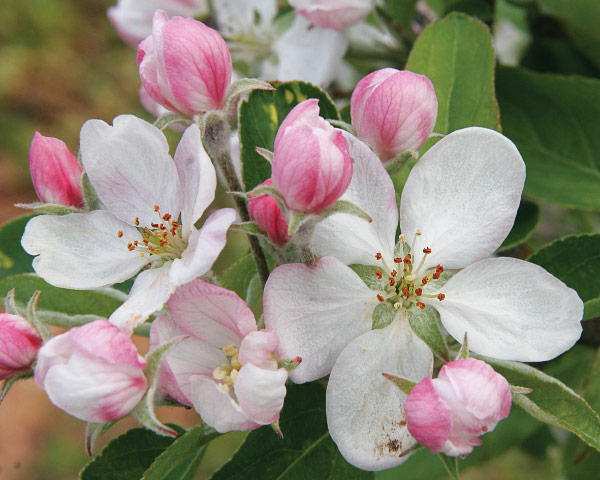 |
|
Photo 1. Apple blossoms in spring bloom. (Photo: Creative Commons) |
By Marcia Anderson, PhD, LTE
U.S. EPA-Center for Integrated Pest Management
Taking a spring ride in the country, I pass numerous fruit orchards, whose flower petals fall across my windshield like giant snowflakes.
I am reminded of a time, a generation ago, when growers sprayed pesticides in the spring in orchards and on farms throughout the nation. Farmers would spray for pests, such as codling moths, before the trees’ buds broke in the spring, then every 7–10 days thereafter.
The spraying occurred whether the pests were there or not because scouting crops for pest levels was not an established strategy. It eventually became clear that pests don’t carry calendars and that their emergence varies from year to year. This validated the need for alternate pest-control methods, including monitoring.
Researchers, in collaboration with farmers, have developed more targeted responses based on differences in pest emergence and life cycles, while calendar spraying has become less prevalent.
Spraying occurred whether the pests were there or not because scouting crops for pest levels was not an established strategy. It eventually became clear that pests don’t carry calendars and that their emergence varies from year to year.
Using Traps to Monitor, Control Pest Populations
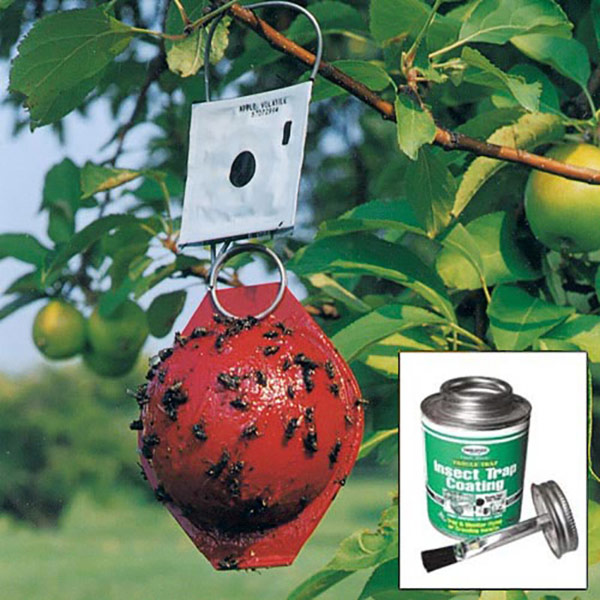 |
|
Photo 2. A red sphere trap hangs in the upper canopy of an apple tree. (Photo: GardensAlive) |
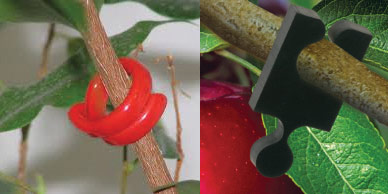 |
|
Photo 3. Sample mating disruptors hung in fruit trees. (Photo: Sentry.com; Gemplers) |
Because fruit season approaches with warming weather, it is no news that codling moths (Cydia pomonella) and the oriental fruit moth (Grapholita molesta) will soon follow. Today’s growers monitor certain pests with the aid of traps designed to include a chemical lure to attract the targeted pest. The lures are often synthetic copies of the pheromones that females emit to attract the males for mating.
In apple orchards, traps such as the one pictured in Photo 2 are hung in the trees. The bottom of the trap is coated with an adhesive to capture the male insects. The normal distribution per full-size tree is six sphere traps. The traps should be hung in the upper third of the canopy and will keep attracting and catching moths for an entire growing season. These are an effective control tactic for apple pests in lieu of pesticide applications.
There are similar sphere traps made for peaches and other trees. Likewise, there are similar mating disruption systems for oriental fruit moths, dogwood borers, peach tree borers, leafrollers, and stink bugs. These pheromone mating disruptor systems come as spirals, ropes, tubes, spray dispensers, clips, and distributors that can be draped or twist-tied onto tree branches. (See Photo 3.)
Altering Pest Behavior through Pheromones
Did you know that warm temperatures in the orchard can cause codling moths and other pest populations to double in a month by triggering females to lay more and stronger eggs? This behavior is attenuated by EPA-registered pheromones.
The male moths follow the pheromone plume to the dispenser, so by the time the males find the females, the females are older and not as reproductive.
Many of the EPA-registered mating disruptor products contain the behavior-modifying pheromone Dodecadien, which is the mating-disruption pheromone affecting the behavior of codling moth, oriental fruit moths, and more.
There are also a number of EPA-registered behavior-modifying pheromones that disrupt the mating communication between adult male and female codling moths, shuck worms, fruit moths, borers, and seed worms. Traps may also be baited with the scent pheromone for the Asian stink bug (Plautia stali), harlequin bug (Murgantia histrionica), and brown marmorated stink bug (Halyomorpha halys).
These are all good pest-population-monitoring strategies that can be used from emergence to late season.
Monitoring Informs Management Decisions
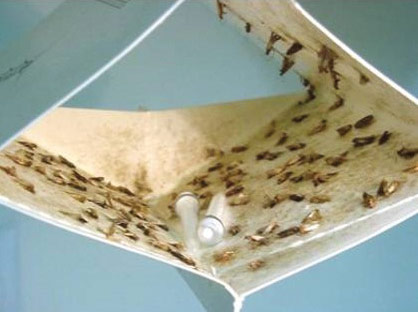 |
|
Photo 4. Pheromone trap. (Photo: Bugwood.org) |
With regular trap monitoring (Photo 4), growers gain an accurate assessment of how many moths are out in the orchard, which in turn helps them determine if and when further treatment is necessary.
When a moth is caught, growers know that the first generation (the overwintering generation) has flown. Then, they can calculate the number of days for the first-generation eggs to hatch. At that point, growers make a decision for action. More traps provide more information and control and allow growers to make better decisions.
It is best to treat large orchard blocks with a quantity of mating disruptors and associated traps, hung early in the spring, so pests are caught as they emerge.
Because codling moths like to congregate, they create “hot spots.” Monitors can indicate to growers where these “hot spots” are located, thus showing where more mating disruptors and/or other control devices should be deployed.
Incorporating Pesticides into a Plan
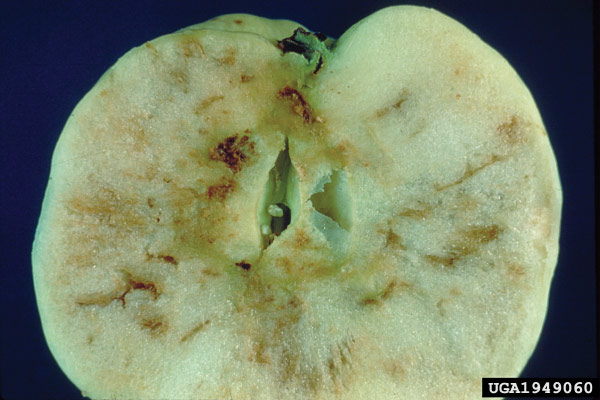 |
|
Photo 5. Apple maggot damage. (Photo: E.H. Glass, NYS AES, Bugwood.org) |
Another effective use of pheromones is in conjunction with a small dose of pesticide. This is an extremely effective and low-cost control to disrupt mating behavior of apple maggots, which are small flies that lay their eggs in fruit. The maggots hatch and eat the fruit (Photo 5). Sometimes, you do not see them until you bite into the fruit.
Pheromone traps can be used to capture apple maggot flies. A red plastic ball with an apple odor in the center resembles an apple hung on a tree that visually and chemically attracts the adult apple maggot. Growers also use an insecticide on top of the fake apple. When an apple maggot lands on it, it ingests the insecticide, which causes the females to cease laying eggs and eventually die. In this way, the amount of insecticide needed is reduced.
When an apple maggot lands on the pheromone trap, it ingests the insecticide, which causes the females to cease laying eggs and eventually die. In this way, the amount of insecticide needed is reduced.
IPM in Orchards
Apple growers have found that scientifically based integrated pest management (IPM) practices have positive, long-term effects on their orchards.
Minimize Risk, Maximize Outcomes
.jpeg) |
|
Photo 6. Apple with a codling moth worm. (Photo: Ward Upham, Kansas State University, Bugwood.org) |
IPM programs in fruit orchards use current, comprehensive information on the life cycles of pests and their interaction with the environment. This information—in combination with available pest control methods—is used to manage pest damage by the most economical means and with the least possible hazard to people, property, and the environment.
IPM takes advantage of all pest management options, including inspection and monitoring for pests, the sanitation and maintenance of the orchard and trees, cultural practices like traps, and the use of reduced-risk pesticides such as pheromone traps. IPM dictates that insecticides be used judiciously as part of an overall pest management program.
There is also an economic impact when growers use IPM. They stand to reduce their two highest bills—chemicals (pesticides and fertilizers) and fuel—when they follow the five components of IPM:
- Pest prevention
- Pest identification
- Setting of economic thresholds for each pest
- Pest population dynamics and damage monitoring
- Using a combination of management tools
IPM dictates that insecticides be used judiciously as part of an overall pest management program.
Increased IPM Adoption for Tree Fruits
IPM has become increasingly ingrained in apple and other fruit tree pest management plans over the past 30 years because most growers live right on their farms. Apple growers have found that the most effective way to control their pests is by using IPM practices that have positive, long-term effects on their orchards.
Therefore, growers monitor their orchards weekly from the beginning of spring through the entire growing season to determine pest pressures. The growers and crop consultants become intimately familiar with their location and learn about past disease, pest pressures, and the ecology of their orchards.
Keep It Clean
Maintenance and sanitation are key parts of preventing pests in fruit orchards. Every year, growers follow a rigorous routine in the fall by cleaning the orchard floor, cutting suckers off tree trunks, and clearing weeds from under the trees. Fallen leaves, grass clippings, and winter prunings are mulched and returned to the soil.
By chopping the leaves into small bits, they hasten decomposition and reduce overwintering options for the pests. This reduces the pest populations that will be in the orchard in the next spring.
Fungal Control through Improved Sanitation
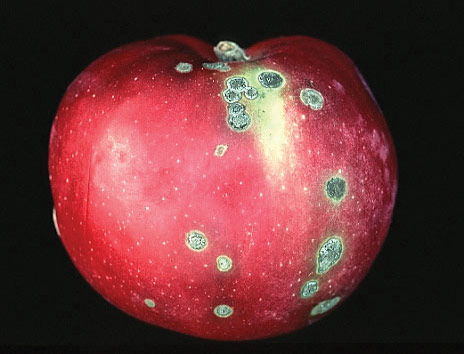 |
|
Photo 7. Apple scab—a persistent fungi in orchards. (Photo: Cornell.edu) |
Simply by maintaining this degree of sanitation, growers have also been successful in reducing the presence of apple scab, one of the most persistent pest problems in orchards.
Apple scab comes from a fungal spore that overwinters on the ground (Photo 7) and normally requires a sprayed fungicide in order to arrest its development. Those spores go on the fruit and make leathery-brown scabs that blemish the fruit.
Blemished fruit is of lower quality, so its value is reduced, leading to an economic loss to the grower. Apple scab also damages the tree because it creates leaf lesions that spread and interfere with photosynthesis. A bad scab infection can shut down an entire tree and spreads quickly throughout the orchard.
Proper Nutrition, Other Strategies
Other pest-prevention methods include planting pest-resistant varieties and replenishing nutrients.
Just like people, apple trees need specific nutrients to keep them healthy, and those nutrients enable them to produce quality fruit. When hundreds of bushels of apples per acre are removed annually, it means a lot of nutrients are removed from the orchard soil.
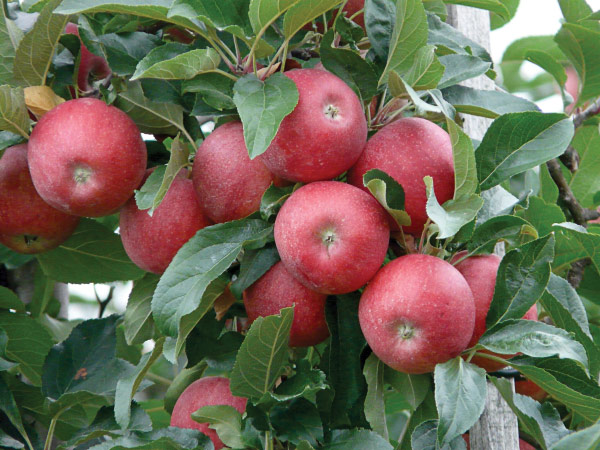 |
|
Photo 8. Fresh, fall apples ready for picking. (Photo: Creative Commons) |
Monitoring soil nutrient levels and adding nutrients, as needed to maintain tree health, is another essential component of IPM. Fruit trees need a wide range of macronutrients (those needed in large quantity to provide energy), including nitrogen, phosphorous, and potassium. Nutrients are added either directly to the soil or through spraying on the tree leaves (foliar application).
Fortunately, many soils in the Northeast have high phosphorous and adequate nitrogen levels. But if nitrogen is needed, it is most often applied through foliar application. Potassium is the macronutrient that needs to be replaced on a regular basis.
By running soil tests and recording the number of bushels of apples that were removed, growers can calculate how much potassium must be added back to the soil. Micronutrients, such as calcium, magnesium, zinc, boron, and manganese, also need to be replenished. These are all added through foliar applications.
Vary Pesticides to Avoid Resistance
There are a few challenges to keep in mind when implementing IPM, not only in fruit orchards, but when controlling any pest.
If pesticides are used, it is important to rotate them. With any pest population, if you use the same pesticide repeatedly, there are always a few pests that survive, creating a resistant population. The resulting resistance erodes the efficacy of overused pesticides.
Apples as a Case Study
So why should we care about pest prevention and the appropriate use of pesticides on our apples in particular? One reason is that apples are very prevalent in the diets of our children. They’re used to make juice and sauce and are eaten raw. They’re good for us! Utilizing the scientifically based best practices of IPM, apple growers can now provide us with high quality apples at reasonable prices.
If you use the same pesticide repeatedly, there are always a few pests that survive, creating a resistant pest population.
Widespread Benefits
Over 90 percent of apple and pear orchards are currently treated with mating disruptors. The next time you eat an apple and do not find a worm, think about your local apple growers and how they are using IPM to provide you with quality produce at reasonable prices.
The Northeastern IPM Center promotes integrated pest management for reducing risks to human health and the environment. If republishing our news, please acknowledge the source (“From Northeast IPM Insights”) along with a link to our website.
